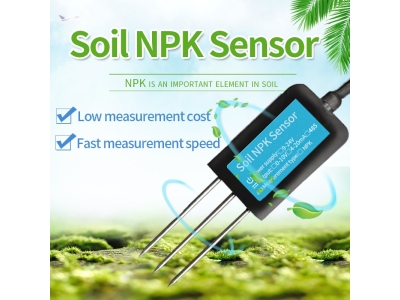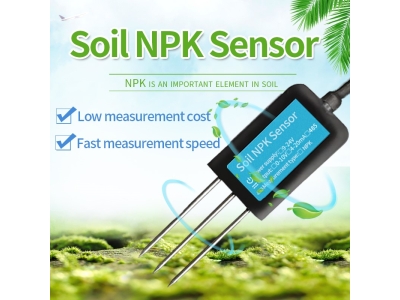n today's era of rapid technological advancements, agriculture is facing numerous challenges. Climate change, soil degradation, and resource scarcity are posing significant obstacles to traditional farming practices. However, with the advent of precision agriculture, also known as smart farming, innovative solutions are emerging to address these challenges. At the heart of precision agriculture lies soil sensor technology, which has the potential to revolutionize soil management and crop cultivation practices. This article will explore the transformative impact of soil sensors on modern farming, including their applications, benefits, and the future of agriculture.

Understanding the Role of Soil Sensors
Soil sensors are advanced devices designed to measure various soil parameters, such as moisture content, temperature, pH levels, nutrient concentrations, and salinity. These sensors utilize different technologies, including capacitance, electrical conductivity, and optical sensing, to gather detailed information about soil conditions. By deploying soil sensor networks across agricultural fields, real-time data on soil conditions can be collected and analyzed to generate insights and recommendations for optimizing nutrient management.
Precision Nutrient Management
One of the primary applications of soil sensor technology is precision nutrient management. Soil nutrient sensors play a crucial role in monitoring nutrient levels in the soil, enabling farmers to implement precise nutrient management strategies. The data collected by these sensors can be used to adjust fertilizer application rates, timing, and placement, thereby minimizing waste and maximizing nutrient uptake by crops. For example, nitrogen sensors can help identify areas within a field with varying nitrogen levels, allowing for targeted fertilizer application rates to optimize crop yields and minimize nitrogen loss into the environment.
Site-Specific Nutrient Management (SSNM)
Site-specific nutrient management (SSNM) involves adjusting fertilizer application rates based on specific soil conditions, crop requirements, and yield goals. Soil sensors provide real-time data on soil conditions, enabling farmers to implement SSNM at a more precise and sustainable level. Additionally, other technologies, such as remote sensing and geographic information systems (GIS), can be utilized to map soil variability and further optimize SSNM practices. By integrating soil sensor data with these technologies, farmers can make informed decisions that enhance nutrient management and promote sustainable crop production.
Optimizing Cover Crop Management
Cover crops are essential components of sustainable agriculture, offering benefits such as soil erosion control, improved soil health, and weed suppression. They also play a vital role in managing soil nutrients by scavenging residual nutrients from previous crops and fixing nitrogen from the atmosphere. However, the management of cover crops can be challenging, as the timing of cover crop termination can significantly impact nutrient availability for subsequent crops. Soil sensors can aid in optimizing cover crop management by providing real-time data on soil moisture and nutrient availability. This data can be used to adjust cover crop termination timing, maximizing the benefits of cover crops for sustainable crop production.
Data-Driven Decision Making
Soil sensor technology generates vast amounts of data on soil conditions and crop performance. This data can be collected and analyzed using sophisticated software platforms to generate insights and recommendations for optimal nutrient management. Advanced analytics and machine learning techniques can identify patterns and trends, enabling data-driven decision making. For instance, soil data can be utilized to identify areas within a field with elevated nutrient levels, allowing for targeted nutrient management practices to maximize crop yields and minimize waste.
Challenges and Opportunities for Adoption
While soil sensor technology holds tremendous potential for enhancing agricultural efficiency and sustainability, there are challenges to its widespread adoption. The cost of equipment and installation, as well as the need for skilled personnel to manage and interpret soil sensor data, are among the primary obstacles. Furthermore, some farmers may be resistant to change traditional farming practices. However, with ongoing technological advancements and increased awareness of the benefits of precision agriculture, the adoption of soil sensor technology is expected to increase in the coming years. Government support and industry collaboration can also play a pivotal role in overcoming adoption barriers.
Future Directions and Impact
Looking ahead, soil sensor technology is poised to play a transformative role in shaping the future of agriculture. As advancements in sensor technology continue, we can expect to see the development of more affordable, scalable, and user-friendly soil sensors. Additionally, the integration of soil sensor data with emerging technologies such as the Internet of Things (IoT) and artificial intelligence (AI) will further enhance the capabilities of precision agriculture. These advancements have the potential to revolutionize farming practices, promoting sustainability, resilience, and productivity in the face of evolving environmental and economic challenges.
Conclusion
Soil sensor technology represents a paradigm shift in modern farming practices,offering the potential to revolutionize how we manage soil health and cultivate crops. With real-time data on soil conditions, farmers can optimize fertilizer application rates, timing, and placement, implement site-specific nutrient management, and enhance cover crop management for sustainable crop production. Data-driven decision making based on soil sensor data can lead to enhanced crop yields, reduced waste, and improved sustainability. While challenges to adoption remain, the potential benefits of soil sensor technology for modern agriculture are significant. By embracing the potential of soil sensor technology, we can pave the way for a more sustainable and resilient agricultural future.






